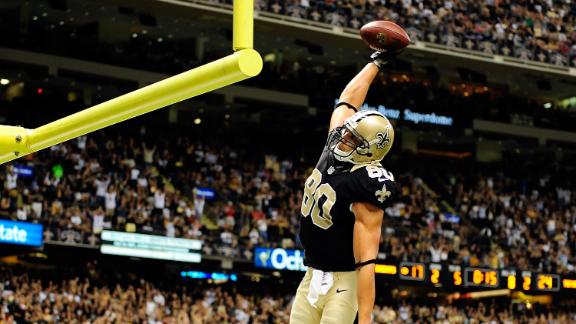With
the crawfish boil over, now we can turn our attention to one of Louisiana’s
other great traditions: the Saints. Unfortunately the 2014 season fell
somewhere between disappointment and disaster. Pundits, Saints fans, and even
the team thought the Saints would be a Super Bowl contender. With little salary
cap space last offseason, the Saints re-signed tight end Jimmy Graham and added
safety Jarius Byrd to bolster the defensive backfield and put the team over the
top. Instead, injuries and ineffectiveness plagued the team throughout the
season. A heartbreaking Week 1 loss to the hated Falcons set the stage for the
miserable season that followed. By the end of the year, the Saints were left
wondering where it had all gone wrong.
This week let’s focus on the most
significant move the Saints have made this offseason: the trade of star tight
end Jimmy Graham and a fourth round pick (109th overall) to the
Seattle Seahawks for center Max Unger and a first rounder (31st
overall). We’ll break down this trade in a few ways; first, did the Saints get
good value for Graham? And second, what does this mean for the Saints going
forward?
 |
| Bye Jimmy! |
Using the draft value chart
created by Chase Stuart of Football Perspective (based on the value produced by
each pick over a 30 year period), the Saints traded away the 109th
pick, worth 4.7 points of approximate
value (a measure of individual player production developed by Pro-Football
Reference). In return, they received the 31st pick worth 12.7, for a
net of 8 AV. 8 points of AV is equivalent to the 65th pick in the
draft (the 1st pick of the third round). On first glance, it seems
impressive that the Saints netted a 1st rounder for Graham. When you
factor in the 4th round pick, the trade is much less than it seems. The
values of Graham and Unger going forward are difficult to discern. Unger missed
ten games last season due to injury and Graham has been similarly hampered by
the injury bug. What is clear is that the Saints traded away their best
offensive player not named Drew Brees for a starting center and the equivalent
of the 65th pick in the draft. Hardly an impressive haul.
The Graham trade does provide the Saints something they desperately needed: salary cap relief in 2016 and 2017. As result of the 4 year, 40 million dollar contract signed last year, Graham counted eight million against the cap this year, nine million in 2016 and ten million in 2017. By trading him the Saints paid a heavy price this year. The Saints shed Graham’s salary in the trade, but the remainder of his salary bonus accelerated onto this year’s cap. By trading him, Graham will eat up nine million dollars in cap space this year. After this year, however, Graham is off the Saints books, freeing up nineteen million dollars for 2016 and 2017. The relief will be especially useful in 2016. Currently, the Saints have 131.5 million committed to the cap for 2016, with Graham’s contract they would have been perilously close to the salary cap ceiling again. Now they have money to devote to other areas of the roster, like signing pass rusher Cameron Jordan to a contract extension.
 |
| Hi, Max! |
What does this mean on the field? The
trade cost the Saints their best offensive weapon. As a tight end, Graham
caused matchup problems for opposing defenses, requiring double teams and
opening up other options for the rest of the offense. While the Saints seem
high on backup Josh Hill, he can’t and won’t replace Graham’s production. With
the downgrade at the tight end spot, the improvements will have to come
elsewhere. Unger should bolster the Saints interior offensive line, helping out
in both pass protection and the run game. Last season, with Unger in the
lineup, the Seahawks averaged 203.8 yards per game rushing. Without him, the
Seahawks averaged nearly fifty yards fewer per game (153.9). A better run game
will help, but it can’t replace Graham.
Overall, it’s hard to see how the
trade helps the Saints in 2015. They traded away the second best tight end in
the NFL for a starting center and the equivalent of the 1st pick in
the third round. The deal provides salary cap relief, but not until 2016 and
2017. Last season, the Saints mortgaged their salary cap future to make a Super
Bowl run. This offseason that mortgage came due.

No comments:
Post a Comment